|
KIMBERLEY TOAD BUSTERS NEWSLETTER
54:
06/04/2014
The Cane Toad is a Key Threatening Process to the Australian Nation
Declared by the Federal Government 12 April 2005
This 54th Kimberley Toad Busters’ Newsletter is produced by Kimberley Specialists
In Research Inc in conjunction with Kimberley Toad Busters Inc. Kimberley
Specialists, a founding member of the Kimberley Toad Busters, continues to support
the campaign against the cane toad by supporting www.canetoads.com.au raising
funds and supporting cane toad scientific research.
2013 United Nations Finalist as well as finalist in 7 other state, national and
international awards since 2006.
Prepared by Jordy Groffen–Researcher at Kimberley Toad Busters.
KTBs are a tax deductible charitable entity. Please see our website for our direct donation
facility, or ways in which you can sponsor community toad busting efforts or one of our
research or educational projects.
IF EVERYONE WAS A TOADBUSTER, THE TOADS WOULD BE BUSTED!
kimberleytoadsbusters@canetoads.com.au
www.kimberleyspecialists.com.au
kimberleyspecialists@westnet.com.au
The Cane Toad is a Key Threatening Process to the Australian Nation
Declared by the Federal Government 12 April 2005.
Contents
Marella Gorge Research Update:
Cane Toads use novel way to invade remote areas of the North Kimberley.
Dutch Animal Scientist returns to KTB
After four months monitoring and trapping the biodiversity in Marella gorge on
Nicholson station, pre cane toads and pre wet season rains, the area experienced a
dramatic change. After more than 330 mm of rain in three days towards the end of
January and close to another 300 mm of rain in February, the Marella gorge system
changed from a tranquil still water gorge, primarily shallow but with some deeper
waterholes, to an exciting fast flooding river with multiple pumping waterfalls.
Two pictures taken at the same location before (left) and after (right) the heavy rainfall. Fortunately the
canoe was taken out of the gorge before the rain.
When KTB started the focussed 6 month research project at Marella Gorge, the
toads were 10 km away from the study area. Jordy Groffen Animal Scientist of KTB
stated; “In normal circumstances toads travel an average of 50-55 km per year and
with the latest weather changes the cane toads hit the study area on the 22nd of
February”. Jordy continues “While we only heard 3 toads during the last survey, we
are sure there are more. We were unable to reach all the areas because of the
flooding and during the next 3 day concentrated survey we should be able to get a
clearer idea of the toad numbers. The toads most likely are in the small waterholes
close to the fast flooding river”.
Zigourney Nielsen, Bachelor of Biological
Sciences and research assistant at KTB for
the last two months witnessed the arrival of
the toads. “It is hard to think that so many
of the animals we have been recording will
now be impacted, with many not surviving.
During focussed and concentrated
biodiversity surveys like the one KTB is
undertaking under Jordy’s direction, you
begin to identify with these animals. Now
that toads have hit Marella and they start
to increase in numbers so much of the
great biodiversity that we have been
monitoring for the last few months will be gone”. Zigourney continues “I definitely will
be following the Marella research closely, and I am excited to see the end results”.
Cane Toads use novel way to invade remote areas of the North Kimberley! |
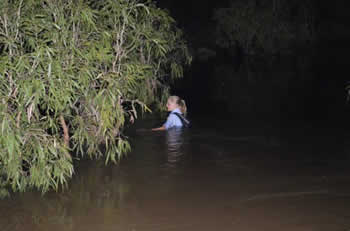 |
Zigourney crossing one of the flooded areas at
night time to go to the trapping site |
|
Photographs taken by KTB volunteer Biodiversity Coordinator has revealed cane
toads are 'rafting' their way into the north Kimberley using river debris and the fast
moving tides of the Cambridge Gulf to move onto remote north coastal areas of the
Kimberley. Gary also spotted cane toads swimming in the middle of the Cambridge
Gulf twenty kilometres north of Wyndham, indicating that even if the toads ‘fell’ off
the ‘rafts’ they were able to cope with the saline conditions of the water.
Lee Scott-Virtue, KTB President & Founder commented. “By ‘rafting’ we are referring
to nature built flotsams of debris such as vegetation and root bound soil, twigs,
grass, small tree’s and general native flora that gets pulled of the river banks when
rivers become flooded. Toads sitting and hiding in some of this debris get pulled into
the river and then sail merrily down-stream until the rivers reside or the ‘raft’ gets
swept into the mouth of the river and into whatever system the rivers are feeding
into. This is the case of the ‘rafts’ holding toads that have made their way into the
Cambridge Gulf”.
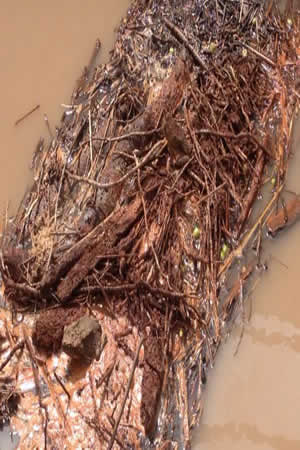 |
The Cambridge Gulf is fed by 5 major river
systems around the Wyndham area, and the 4
cane toads, male and female, photographed
on the rafts of ‘flotsam’ could have come down
any one of these river systems. Once the
flotsam enters the Cambridge Gulf the tides
take over swiftly.
Jordy Groffen, KTB Animal scientist and
researcher commented. “Cane toads are
capable of surviving for weeks on these ‘rafts’ and with up to 9 metre tide changes and swift
currents these rafts can carry toads a long way
in a very short time. If they are ‘lucky’ enough
to land along the coast near fresh water, two
females and two males are capable of
producing up to 70,000 eggs very quickly”.
KTB have witnessed this ‘rafting’ ability of
toads in the Victoria River system where toads
were able to use these flotsams of debris to
colonise areas such as Legune Station, well
ahead of the main colonising frontline being
monitored and followed by KTB volunteers.
KTB also witnessed toads using flotsam on
Lake Argyle and on the Ord River so this is not
a random phenomena. |
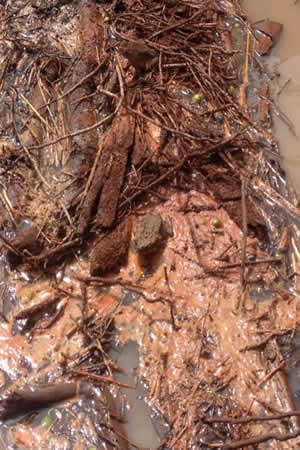 |
Photo’s by Gary Rethus.
One of the problems is that major rivers such as the Prince Regent, Roe and Hunter
rivers, and all the tributaries and rivers that flow into these three systems will have
the same scenario (this actually includes all Kimberley river systems that flow into
the sea) and once toads hit their catchment areas, wet season floods are then likely
to take toads (on flotsams of debris during the wet season) across to islands located
out from the mouth of these river systems.
Dean Goodgame, KTB Board member commented. “It is a concern that the state
government’s mantra, as presented by Environment Minister Albert Jacobs in
regards to the creation of conservation reserves on 30 Kimberley islands, as toad
free zones is more than a little optimistic. With the majority of these islands located
along a coastal area that is fed by several large Kimberley river systems, these
islands are unlikely to remain toad free, at least in the long term. Sacrificing the rest
of the Kimberley for the island program does not make good sense”.
Dean went on to say “Using community to keep on working at reducing cane toad
numbers and at least minimising toad impact on native biodiversity across the
Kimberley, and utilising their man-power to help with the Island project in the future
makes much more sense. The government should be supporting and working with
the community and the rafting toads are a classic example of the government not
being advised on the cane toad issue appropriately”.
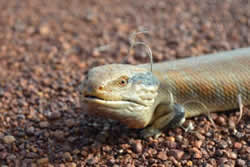 |
The last word goes to Jordy Groffen, KTB Animal Scientist and Researcher. “I am not
sure what the State Environment Minister does not understand about the aims of the
KTB? The work of the Kimberley Community group Kimberley Toad Busters has
clearly shown that by controlling cane toad
population numbers in a given area you minimise the
chance of native predators attacking and consuming
a toad, which in turn reduces the number of native
animals dying from the direct impact of the cane
toad. Keeping toad numbers under control also helps
the smaller insect eating native predators such as
frogs, smaller skinks and lizards by reducing food
competition”.
Photo by Jordy Groffen. |
Dutch Animal Scientist returns to KTB
Animal Scientist Leonie Jacobs from the
Netherlands has returned to Australia to assist
KTB in the Marella gorge research project. Leonie
volunteered with KTB for 9 months in 2012 and
assisted KTB with research projects such as Jordy
Groffen’s lungworm research. With Leonie’s
research background she was able to also
undertake an independent research project with
KTB, looking at the coping style of cane toads
when they are put under pressure. During Leonie’s
time with KTB she also assisted KTB with
biodiversity surveys and gave educational talks.
|
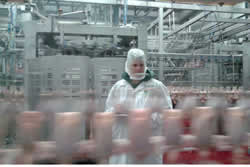 |
Leonie checking chicken carcasses for
injuries and quality for her PhD project |
|
Leonie started her PhD on “Welfare of broiler chickens during transport” in Belgium
at the beginning of 2013. Leonie is happy to be back in the Kimberley, and KTB are
happy that Leonie has decided to take her 4 week break from her PhD research, the
cold and wet weather of Belgium to spend this time helping KTB and Jordy with the
Marella Gorge project.
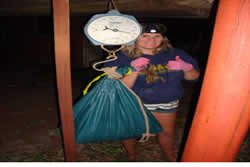 |
Leonie with the catch of the
evening, 32 kilo of toads |
|
Leonie stated “I loved the 9 months that I worked with
KTB and the work they are doing in trying to reduce toad
impacts on the native wildlife. I am really excited to be
back in the Kimberley and to work with them again”.
Animal Scientist Jordy Groffen of KTB stated “It is great
Leonie is back to help, and that she is prepared to fly at
her own expense and to volunteer her time. She is an
excellent researcher and scientist and good in the field”. “We can definitely use her help and expertise now the
cane toads are the Marella gorge study area” Jordy
continued.
The last word goes to Lee Scott-Virtue founder and President of KTB. |
“Without research scientists such as Leonie Jacobs, Jordy Groffen, Gary Rethus and
Zigourney Nielsen willing to volunteer their time to assist KTB with their biodiversity
and other research projects it would be difficult to continue this work. Many of our
biodiversity and biological research programs were initiated several years ago, and
made possible by the financial support of our state government. The withdrawal of
this support has made it very difficult for KTB to continue some of these programs”.
Don’t forget to “Like” us on Facebook and Follow us on Twitter!
For further information contact
Jordy Groffen: 08 91682576
Lee Scott-Virtue: 08 91687080
If everyone became a toad buster.
The toads would be busted!

Kimberley Toad Busters awards!
For more information on any of the articles contact:
Lee Scott-Virtue: KTB Founder & President 08 9168 7080 kimberleytoadbusters@canetoads.com.au
All donations are tax deductible.
Sponsors


|





